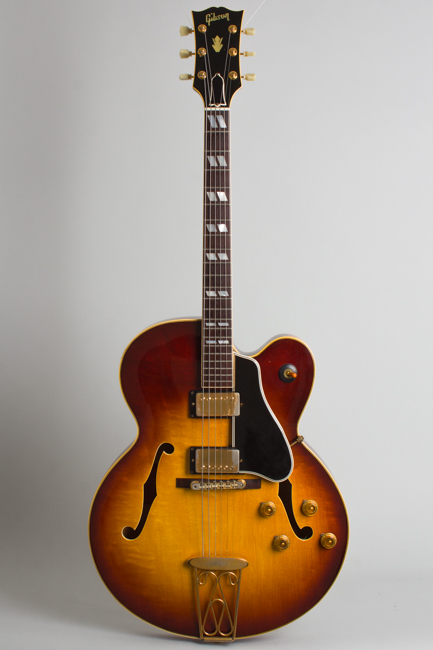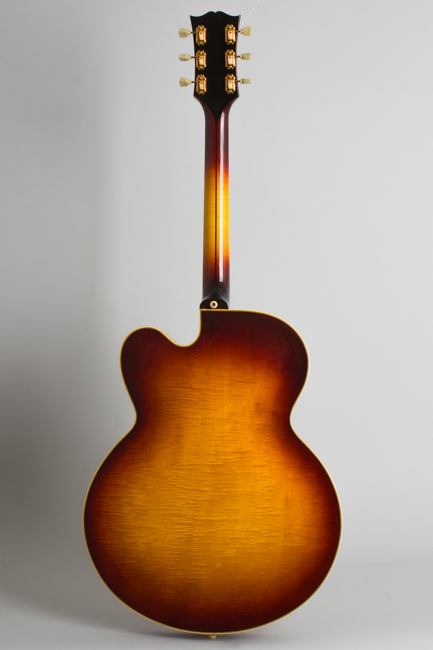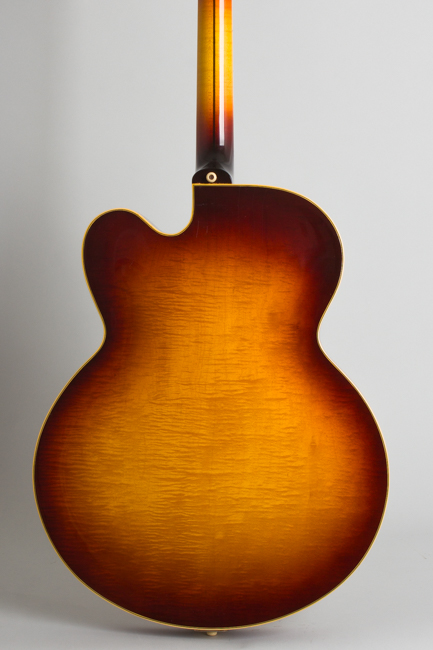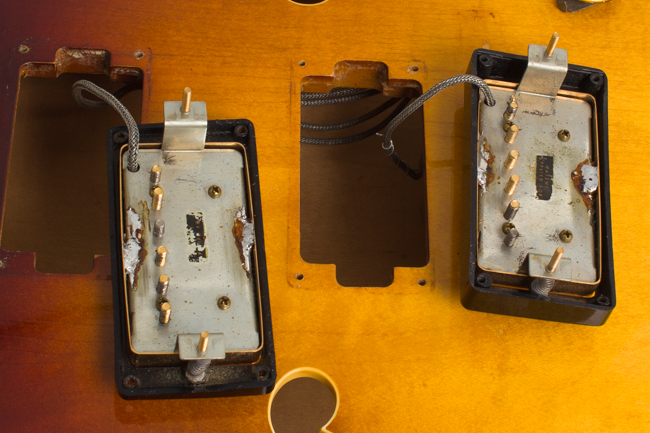Gibson ES-350T Thinline Hollow Body Electric Guitar (1960)
Gibson ES-350T Model Thinline Hollow Body Electric Guitar (1960), made in Kalamazoo, Michigan, serial # A-34174, sunburst lacquer finish, laminated maple body and neck, rosewood fingerboard, original brown leather covered hard shell case.
This guitar is a lovely example of one of the Gibson company's classiest 1950's thinline electrics, the ES-350T. It was shipped in July 1960, right at the apex of the company's classic Kalamazoo era. With a vivid sunburst finished maple top and gold hardware it is certainly a looker, and with two PAF humbucking pickups it's no slouch in the sonic department either!
The ES-350T was introduced in 1955 as a "modernized" version of the ES-350 electric archtop, a 17" full-depth guitar which had been in production since the late 1940s. The inspiration for the new model lay with two of the company's Nashville endorsers, Hank Garland and Billy Byrd. They suggested that the standard 17" archtop guitar body could be made thinner at the rim and thus more comfortable to play, especially standing up as was increasingly common. They also requested a thinner neck with a short 23 3/8 scale length and narrower nut, reportedly to enable guitarists with normal-sized fingers to play the extended chords as used particularly by jazz great Tal Farlow requiring long fingerboard stretches.
The model created for them was dubbed the Byrdland and featured the solid, carved-wood construction of the L-5CES. Gibson applied the same formula to the existing ES-350 resulting in this redesigned ES-350T with a thinner 2 1/4" rim and the short scale neck, built on a laminated maple body with midline ornamentation. The model was prototyped in mid-1955, but only a handful were shipped out before 1956.
While not as deluxe as the Byrdland this was moderately high end instrument that would run you $435 (closer to $500 with the original case!) in 1960 for a sunburst finish. While never a huge seller the model was considered a relative sales success, at least at first. Early in 1957 the ES-350T was one of the first Gibson models to be fitted with the brand new humbucking pickups, the now-legendary PAFs. This guitar carries an "A" series serial number indicating shipment in summer 1960, one of only 71 sold that year. Internal competition from the new semi-solid ES-335 series was noticeably cutting into sales of the fully-hollow thinlines by that point. This fading model would be restyled with a sharp cutaway the next year, and then sadly discontinued after 1963.
Despite its relatively short life the ES-350T is a classic Gibson creation sporting some of the company's iconic touches. The 17" wide body and neck are made of laminated maple finished in gleaming sunburst lacquer. The body is triple-bound, the headstock single-bound with a "crown" inlay under the pearl Gibson logo. The bound rosewood fingerboard has Gibson's signature split parallelogram inlay. The ES-350T had its own proprietary loop tailpiece with the model name engraved on the oval crossbar.
All hardware is gold-plated, including on this guitar correct style repros of what would have been Kluson Deluxe tuners with keystone buttons and of course those twin PAFs. These original humbucking pickups have gone down in legend as some of the very best ever made, with a super touch-sensitive feel and splendid tone from clean sparkle to overdriven raunch. The 350T's slightly narrower neck means the pickups fitted are built with a tighter polepiece spread than the standard version, making them unsuitable for Les Paul recreations and thus less likely to be robbed from their original home!
This splendid and fairly rare guitar is an excellent player straight from Gibson's glory days. The ES-350T has a sublime rock and roll pedigree; the rarer natural finished version served as Chuck Berry's main squeeze at the height of his 1950s career and can be seen on several LP covers. Beyond this association the ES-350T can handle anything from fluid jazz to country twang equally well. Still, if you clang out the intro to "Johnny B. Goode", it's just like ringin' a bell.
Overall length is 41 1/2 in. (105.4 cm.), 17 in. (43.2 cm.) wide at lower bout, and 2 1/4 in. (5.7 cm.) in depth, measured at side of rim. Scale length is 23 3/8 in. (594 mm.). Width of nut is 1 5/8 in. (41 mm.).
This guitar is in rather dashing and largely original condition having generally fared very well over the last 65 years. It shows some signs of play, a scuff here and there, and a touch of finishing checking from age but is free of any cracks or serious flaws. There is one completely topical scuff a couple inches below the heel, really not many other flaws. It still proudly shows off an attractive rich and vibrant sunburst finish, the standard livery for this model with minimal fade and free from any touch up or overspray.
The original PAFs are still in place; the covers were removed and re-soldered at some point (probably to check the color of the coils) but the namesake stickers are still intact. The original electronics are intact including the wiring and pots; the 3-way tone selector switch retains the original rubber mounting ring but the amber tip is a repro.
The gold plating shows its age in some places, mostly loss on the PAF pickup covers and ends of the bridge. The original tailpiece and even seemingly the end pin are in place; this guitar was never "Bigsbified" as many were. The gilded Tune-O-Matic bridge is original from the Nylon saddles to the base, and the original pickguard rests on its original bracket; the lower mounting screw appears replaced.
The original Klusons have been replaced with modern gold repros that shine just a little bit more than the rest of the hardware and have ever-so-slightly oversize washers on the front of the headstock. Like many other Gibsons of this era, there is a high likelihood judging by the rest of the condition of the guitar that these were changed because the original tuner buttons began to crumble. A period plastic strap button was added to the heel, probably when the guitar was new.
The original small frets show commensurate wear with the rest of the guitar, with minimal signs of wear. They may have been recrowned a bit judging in lower positions. Overall this is an excellent example of a true Gibson fan favorite thinline, original where it really counts and a splendid piece of PAF era Gibson greatness. It still resides in its slightly worn but fully functional original brown Lifton HSC. Excellent - Condition.
This guitar is a lovely example of one of the Gibson company's classiest 1950's thinline electrics, the ES-350T. It was shipped in July 1960, right at the apex of the company's classic Kalamazoo era. With a vivid sunburst finished maple top and gold hardware it is certainly a looker, and with two PAF humbucking pickups it's no slouch in the sonic department either!
The ES-350T was introduced in 1955 as a "modernized" version of the ES-350 electric archtop, a 17" full-depth guitar which had been in production since the late 1940s. The inspiration for the new model lay with two of the company's Nashville endorsers, Hank Garland and Billy Byrd. They suggested that the standard 17" archtop guitar body could be made thinner at the rim and thus more comfortable to play, especially standing up as was increasingly common. They also requested a thinner neck with a short 23 3/8 scale length and narrower nut, reportedly to enable guitarists with normal-sized fingers to play the extended chords as used particularly by jazz great Tal Farlow requiring long fingerboard stretches.
The model created for them was dubbed the Byrdland and featured the solid, carved-wood construction of the L-5CES. Gibson applied the same formula to the existing ES-350 resulting in this redesigned ES-350T with a thinner 2 1/4" rim and the short scale neck, built on a laminated maple body with midline ornamentation. The model was prototyped in mid-1955, but only a handful were shipped out before 1956.
While not as deluxe as the Byrdland this was moderately high end instrument that would run you $435 (closer to $500 with the original case!) in 1960 for a sunburst finish. While never a huge seller the model was considered a relative sales success, at least at first. Early in 1957 the ES-350T was one of the first Gibson models to be fitted with the brand new humbucking pickups, the now-legendary PAFs. This guitar carries an "A" series serial number indicating shipment in summer 1960, one of only 71 sold that year. Internal competition from the new semi-solid ES-335 series was noticeably cutting into sales of the fully-hollow thinlines by that point. This fading model would be restyled with a sharp cutaway the next year, and then sadly discontinued after 1963.
Despite its relatively short life the ES-350T is a classic Gibson creation sporting some of the company's iconic touches. The 17" wide body and neck are made of laminated maple finished in gleaming sunburst lacquer. The body is triple-bound, the headstock single-bound with a "crown" inlay under the pearl Gibson logo. The bound rosewood fingerboard has Gibson's signature split parallelogram inlay. The ES-350T had its own proprietary loop tailpiece with the model name engraved on the oval crossbar.
All hardware is gold-plated, including on this guitar correct style repros of what would have been Kluson Deluxe tuners with keystone buttons and of course those twin PAFs. These original humbucking pickups have gone down in legend as some of the very best ever made, with a super touch-sensitive feel and splendid tone from clean sparkle to overdriven raunch. The 350T's slightly narrower neck means the pickups fitted are built with a tighter polepiece spread than the standard version, making them unsuitable for Les Paul recreations and thus less likely to be robbed from their original home!
This splendid and fairly rare guitar is an excellent player straight from Gibson's glory days. The ES-350T has a sublime rock and roll pedigree; the rarer natural finished version served as Chuck Berry's main squeeze at the height of his 1950s career and can be seen on several LP covers. Beyond this association the ES-350T can handle anything from fluid jazz to country twang equally well. Still, if you clang out the intro to "Johnny B. Goode", it's just like ringin' a bell.
Overall length is 41 1/2 in. (105.4 cm.), 17 in. (43.2 cm.) wide at lower bout, and 2 1/4 in. (5.7 cm.) in depth, measured at side of rim. Scale length is 23 3/8 in. (594 mm.). Width of nut is 1 5/8 in. (41 mm.).
This guitar is in rather dashing and largely original condition having generally fared very well over the last 65 years. It shows some signs of play, a scuff here and there, and a touch of finishing checking from age but is free of any cracks or serious flaws. There is one completely topical scuff a couple inches below the heel, really not many other flaws. It still proudly shows off an attractive rich and vibrant sunburst finish, the standard livery for this model with minimal fade and free from any touch up or overspray.
The original PAFs are still in place; the covers were removed and re-soldered at some point (probably to check the color of the coils) but the namesake stickers are still intact. The original electronics are intact including the wiring and pots; the 3-way tone selector switch retains the original rubber mounting ring but the amber tip is a repro.
The gold plating shows its age in some places, mostly loss on the PAF pickup covers and ends of the bridge. The original tailpiece and even seemingly the end pin are in place; this guitar was never "Bigsbified" as many were. The gilded Tune-O-Matic bridge is original from the Nylon saddles to the base, and the original pickguard rests on its original bracket; the lower mounting screw appears replaced.
The original Klusons have been replaced with modern gold repros that shine just a little bit more than the rest of the hardware and have ever-so-slightly oversize washers on the front of the headstock. Like many other Gibsons of this era, there is a high likelihood judging by the rest of the condition of the guitar that these were changed because the original tuner buttons began to crumble. A period plastic strap button was added to the heel, probably when the guitar was new.
The original small frets show commensurate wear with the rest of the guitar, with minimal signs of wear. They may have been recrowned a bit judging in lower positions. Overall this is an excellent example of a true Gibson fan favorite thinline, original where it really counts and a splendid piece of PAF era Gibson greatness. It still resides in its slightly worn but fully functional original brown Lifton HSC. Excellent - Condition.












